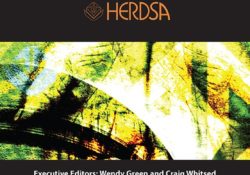eric.ed.gov har udgivet: Every day, we learn what works so students can make greater progress. Six years after No Child Left Behind’s passage–and midway to the nation’s goal of having students on grade level or better in reading and math by 2014–we have collected more data than ever before about the academic performance of our students and schools. This information enables all of us to chart where we are as individual states and as a nation and to map a course of action for future progress. This brochure describes in chart form: (1) Arizona At a Glance (Student Demographics); (2) Arizona’s Record of Achievement (Reading and Math Achievement for 2006-2007); (3) Achievement Trends; (4) Preparing Arizona Students for Success (Arizona’s High School Graduation Rate 2008) and High School Students Taking… Continue Reading →
Like this:
Like Loading...
eric.ed.gov har udgivet: Every day, we learn what works so students can make greater progress. Six years after No Child Left Behind’s passage–and midway to the nation’s goal of having students on grade level or better in reading and math by 2014–we have collected more data than ever before about the academic performance of our students and schools. This information enables all of us to chart where we are as individual states and as a nation and to map a course of action for future progress. This brochure describes in chart form: (1) Colorado At a Glance (Student Demographics); (2) Colorado’s Record of Achievement (Reading and Math Achievement for 2006-2007); (3) Achievement Trends; (4) Preparing Colorado Students for Success (Colorado’s High School Graduation Rate 2006 and High School Students Taking… Continue Reading →
Like this:
Like Loading...
eric.ed.gov har udgivet: This publication compares first-generation students (i.e., those whose parents have no more than a high school education) with their peers whose parent or parents attended college. It focuses on mathematics course taking–the effectiveness of taking algebra in 8th grade and advanced math courses in high school for subsequent college enrollment–and planning strategies students used to prepare for college. The report also examines the involvement of students’ parents, teachers, and other “institutional agents” capable of helping them prepare for college. The results of the study offer both negative and positive findings concerning the experiences of first-generation students. On the negative side, even after controlling for measures of academic achievement, family income, family structure (single versus two parents), and other related characteristics, first-generation students were less likely than their… Continue Reading →
Like this:
Like Loading...
eric.ed.gov har udgivet: Every day, we learn what works so students can make greater progress. Six years after No Child Left Behind’s passage–and midway to the nation’s goal of having students on grade level or better in reading and math by 2014–we have collected more data than ever before about the academic performance of our students and schools. This information enables all of us to chart where we are as individual states and as a nation and to map a course of action for future progress. The foundation of our success will depend on our continued commitment to the following core principles: (1) High Standards; (2) Annual Assessments; (3) Accountability for Results; (4) Highly Qualified Teachers in Every Classroom (HQT); (4) Information and Options for Parents; (5) All Children on… Continue Reading →
Like this:
Like Loading...
tandfonline.com har udgivet en rapport under søgningen “Teacher Education Mathematics”: ABSTRACT ABSTRACT The higher education market has prompted universities to justify their value and worth, especially to students. In Australia, New Zealand and the UK, it is increasingly common for universities to advertise their vision to prospective students, through Graduate Attributes, and showcase the sets of skills and competencies their graduates would develop throughout a degree. Whilst there are extensive studies in Australasia, research in the UK context is limited. This paper presents what we believe is the first national mapping of graduate attributes proposed by UK universities. Our analysis suggests four discourses that characterise the overarching qualities that UK students can expect to embody by graduation: self-awareness & lifelong learning, employability & professional development, global citizenship & engagement and… Continue Reading →
Like this:
Like Loading...
tandfonline.com har udgivet en rapport under søgningen “Teacher Education Mathematics”: ABSTRACT ABSTRACT It is commonly assumed that the reason many young people do not participate in informal STEM education (ISE) is because they lack interest in STEM. This paper draws on survey (n = 1,624) and qualitative data (n = 36) with young people aged 11–14 to examine the ways in which science dispositions, demographic characteristics, ‘consumption’ of cultural practices and exclusion interact to produce unequal forms of STEM participation. Latent class analysis generated six groups within our quantitative dataset: three groups who infrequently participated in designed and community ISE practices (Underserved Tech Enthusiasts, Underserved Creatives and Underserved Scientists), one group who only participated in specific forms of ISE practices (Partly Served Generalists) and two groups who frequently participated across a broad range of… Continue Reading →
Like this:
Like Loading...
eric.ed.gov har udgivet: Every day, we learn what works so students can make greater progress. Six years after No Child Left Behind’s passage–and midway to the nation’s goal of having students on grade level or better in reading and math by 2014–we have collected more data than ever before about the academic performance of our students and schools. This information enables all of us to chart where we are as individual states and as a nation and to map a course of action for future progress. This brochure shows in chart form: (1) Alabama At a Glance (Student Demographics); (2) Alabama’s Record of Achievement (Reading and Math Achievement for 2006-2006); (3) Achievement Trends (Reading and Math); (4) Preparing Alabama Students for Success (Alabama’s High School Graduation Rate 2006 and High… Continue Reading →
Like this:
Like Loading...
tandfonline.com har udgivet en rapport under søgningen “Teacher Education Mathematics”: Wicked problems: a mapping review of the literature Link til kilde
Like this:
Like Loading...
tandfonline.com har udgivet en rapport under søgningen “Teacher Education Mathematics”: Barapa Country through Barapa eyes: cultural mapping of Gunbower Island, Australia Link til kilde
Like this:
Like Loading...
tandfonline.com har udgivet en rapport under søgningen “Teacher Education Mathematics”: Abstract Abstract This paper presents a longitudinal classification of the impact that universities have on strategy research from three decades of publications, between 1987 and 2016, by using bibliometric techniques and distance-based analysis of networks applied at the level of universities. Using the WoS database, this study proposes a general overview of three decades of strategic management research. Using these techniques we (i) categorize the last 30 years of academic production of research institutions in terms of strategy, evaluating their impact; (ii) analyze which universities are publishing the most in journals whose scope of publication covers strategic management; and (iii) map the network of collaboration structures among research organizations, determining its relationship and analyzing its evolution in those three decades. We… Continue Reading →
Like this:
Like Loading...




